In a Classic style course, all the Test Availability options are grouped together on the test options page immediately after the Test Information section.
Make Available to Students
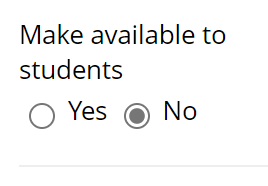
Choose YES on the "Make available to students" option if you want the test to be made available. If you plan to make the test available automatically using the Display After date and time, you'll need to select YES here as well (otherwise, all other options settings will be ignored). If you plan to manually turn the test on when you're ready for students to take it, choose NO.
Add a New Announcement
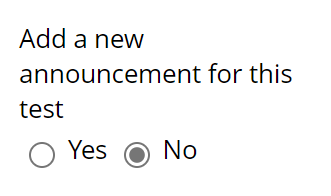
Choose YES on the "Add a new announcement for this test" option if you want Blackboard to automatically post a brief announcement when the test becomes available. The announcement will include only the test name, its location, and a course link to the test.
Multiple Attempts

Check the Multiple Attempts box if you would like students to be able to submit the test more than once. When this box is checked you will be able to choose to give the students have unlimited attempts or a set number of attempts.
When this option is selected, you'll also need to decide how the Grade Center will handle scoring the attempt(s). You can choose to use the latest attempt, the highest grade, the lowest grade, the first attempt, or an average of all the graded attempts. You should be sure to let students know how you'll be handling multiple attempts.
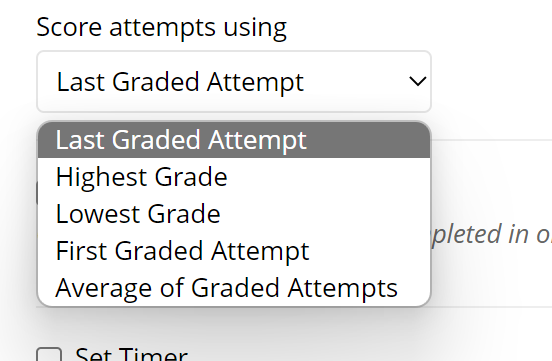
Force Completion

Check the Force Completion box if you want to set the test so that a student cannot exit and re-enter the test.
While this seems like an obvious choice for most exams, enabling force completion can make managing exams more complicated. Specifically, if a student loses access to a Force Completion exam (their internet connection drops, or their web browser freezes), they will not be able to get back in and pick up where they left off. The student will need to start the test over with a new attempt. If multiple attempts are not enabled, the instructor will need to use availability exceptions to give the student an additional attempt.
When Force Completion is turned off, students who get kicked out of a test will be able re-open their attempt and pick up where they left off.
Time Limit

Setting a time limit on the amount of time a student has to take an exam is useful for many reasons. Time limits help students set expectations about the test (consider a 20-question exam with a 10-minute time limit as compared to a 20-question exam with a 30-minute time limit), help reduce instances of cheating, and make it much easier to identify and set appropriate accommodations for students that need them.
The timer option lets you establish the expected completion time for the test. To apply a timer, check the Set Timer box and enter the number of minutes students have to complete the test. While taking the test, Blackboard will display a student's remaining time.
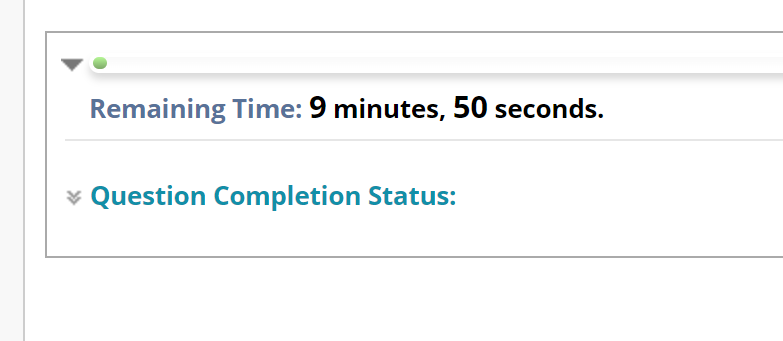
If Force Completion is not turned on -- meaning students can exit and re-enter the test -- you should be aware that the timer will continue to count down, even when a student is not in the exam. This means, if a test has a 30-minute time limit and a student begins the exam, closes it after 10 minutes, then re-opens the exam 15 minutes later, they will have 5 minutes remaining when they re-open the exam.
If you turn Auto-Submit on, the test will automatically save and submit when time expires.
If Auto-Submit is not turned on, students will be allowed to continue the test after the time limit is up. The test will not be automatically scored on submission, even if it consists entirely of self-scoring items (e.g., no essay or short answer questions). Instead, the over-time test will be marked "Needs Grading" (the "!" icon in the Grade Center).
For tests without Auto-Submit, you should let your students know in advance (ideally on the syllabus) how you will handle scoring over-time submissions. For example, you may want to take off points equal to one question at 30-seconds over time, three questions at the 1-minute mark, etc.
Availability Window

The Display After and Display Until fields let you set a window of time that a link to the test is visible to students in the content area.
This feature only works if "Make available to students" (above) is set to Yes.
Once the test is launched, the Display Until date and time will not factor into a student's attempt. Display Until does not deactivate or lock the exam in any way, it simply hides the test link from the students.
Please look at our page on Due Dates, Durations, and Availability for more information on how Time Limits interact with Availability Windows and Due Dates.
Password

If you want to limit access to this exam to only students who have a password, check this box, and enter a password.
NOTE: When turned on for an exam, LockDown Browser enters a password into this field. Once you have required LockDown Browser for an exam, do not change the password and do not give the password out.
This password is what ensures students are taking the test using LockDown Browser. When a student launches LockDown Browser and launches the test, LockDown Browser invisibly passes this password off to Blackboard, letting the student into the exam.
If a student has this password, they will be able to access the test without using LockDown Browser.
If the password is changed or removed, LockDown Browser will be unable to launch the test.
If you want to require students use LockDown Browser and enter a password (a recommendation for live-proctoring), you should set the password in the LockDown Browser dashboard.
Restrict Location
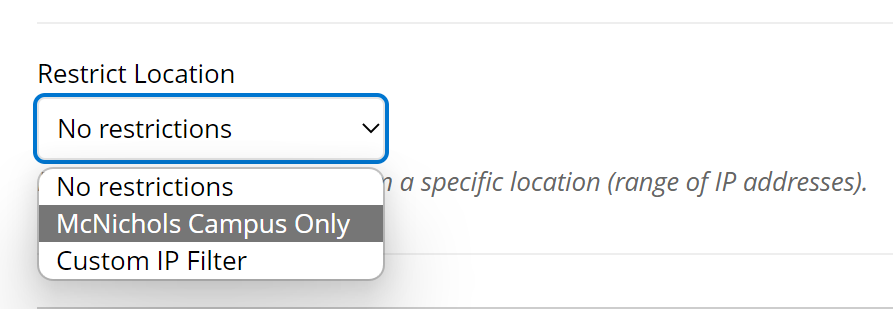
If you are using Blackboard to provide an exam that students will be taking on-campus, you can use the Restrict Location list to limit access to only students on the McNichols campus (other campus restrictions are not currently available).